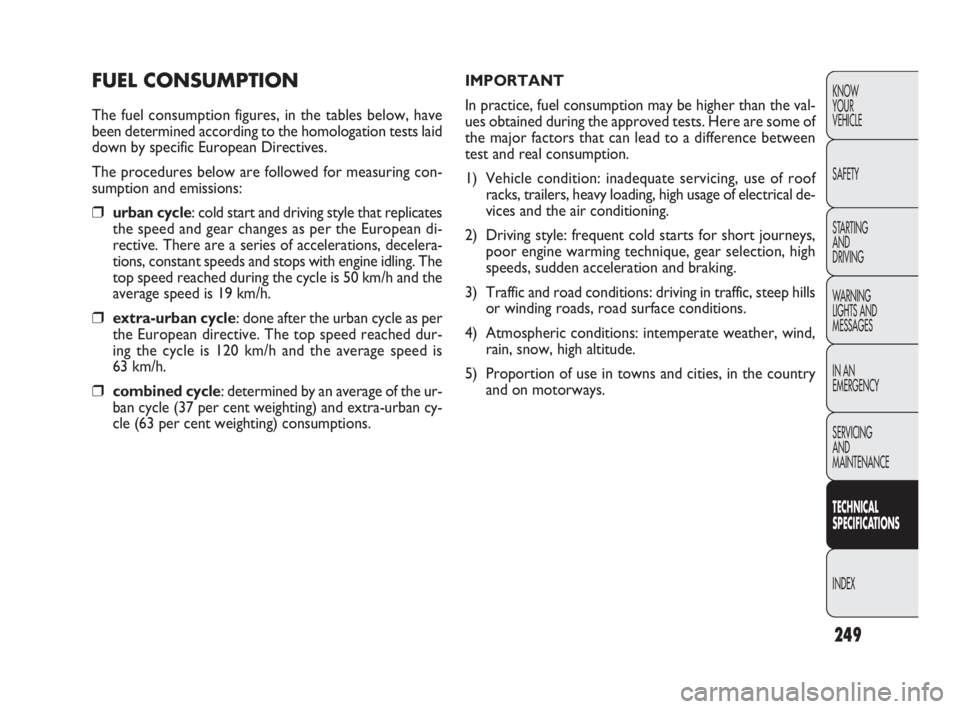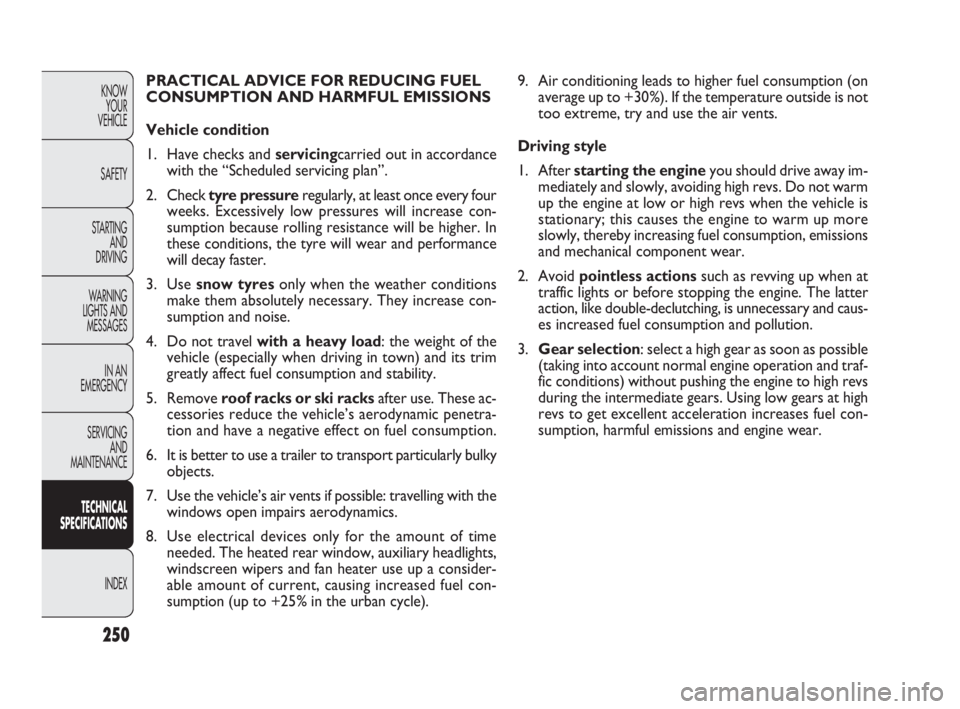air condition FIAT DOBLO COMBI 2010 Owner handbook (in English)
[x] Cancel search | Manufacturer: FIAT, Model Year: 2010, Model line: DOBLO COMBI, Model: FIAT DOBLO COMBI 2010Pages: 274, PDF Size: 6.16 MB
Page 250 of 274

249
KNOW
YOUR
VEHICLE
SAFETY
STARTING
AND
DRIVING
WARNING
LIGHTS AND
MESSAGES
IN AN
EMERGENCY
SERVICING
AND
MAINTENANCE
TECHNICAL
SPECIFICATIONS
INDEX
FUEL CONSUMPTION
The fuel consumption figures, in the tables below, have
been determined according to the homologation tests laid
down by specific European Directives.
The procedures below are followed for measuring con-
sumption and emissions:
❒urban cycle: cold start and driving style that replicates
the speed and gear changes as per the European di-
rective. There are a series of accelerations, decelera-
tions, constant speeds and stops with engine idling. The
top speed reached during the cycle is 50 km/h and the
average speed is 19 km/h.
❒extra-urban cycle: done after the urban cycle as per
the European directive. The top speed reached dur-
ing the cycle is 120 km/h and the average speed is
63 km/h.
❒combined cycle: determined by an average of the ur-
ban cycle (37 per cent weighting) and extra-urban cy-
cle (63 per cent weighting) consumptions.IMPORTANT
In practice, fuel consumption may be higher than the val-
ues obtained during the approved tests. Here are some of
the major factors that can lead to a difference between
test and real consumption.
1) Vehicle condition: inadequate servicing, use of roof
racks, trailers, heavy loading, high usage of electrical de-
vices and the air conditioning.
2) Driving style: frequent cold starts for short journeys,
poor engine warming technique, gear selection, high
speeds, sudden acceleration and braking.
3) Traffic and road conditions: driving in traffic, steep hills
or winding roads, road surface conditions.
4) Atmospheric conditions: intemperate weather, wind,
rain, snow, high altitude.
5) Proportion of use in towns and cities, in the country
and on motorways.
219-260 DOBLO LUM EN 2e 7.0 27-05-2010 15:10 Pagina 249
Page 251 of 274

250
KNOW
YOUR
VEHICLE
SAFETY
STARTING
AND
DRIVING
WARNING
LIGHTS AND
MESSAGES
IN AN
EMERGENCY
SERVICING
AND
MAINTENANCE
TECHNICAL
SPECIFICATIONS
INDEX
9. Air conditioning leads to higher fuel consumption (on
average up to +30%). If the temperature outside is not
too extreme, try and use the air vents.
Driving style
1. After starting the engineyou should drive away im-
mediately and slowly, avoiding high revs. Do not warm
up the engine at low or high revs when the vehicle is
stationary; this causes the engine to warm up more
slowly, thereby increasing fuel consumption, emissions
and mechanical component wear.
2. Avoid pointless actions such as revving up when at
traffic lights or before stopping the engine. The latter
action, like double-declutching, is unnecessary and caus-
es increased fuel consumption and pollution.
3.Gear selection: select a high gear as soon as possible
(taking into account normal engine operation and traf-
fic conditions) without pushing the engine to high revs
during the intermediate gears. Using low gears at high
revs to get excellent acceleration increases fuel con-
sumption, harmful emissions and engine wear. PRACTICAL ADVICE FOR REDUCING FUEL
CONSUMPTION AND HARMFUL EMISSIONS
Vehicle condition
1. Have checks and servicingcarried out in accordance
with the “Scheduled servicing plan”.
2. Check tyre pressure regularly, at least once every four
weeks. Excessively low pressures will increase con-
sumption because rolling resistance will be higher. In
these conditions, the tyre will wear and performance
will decay faster.
3. Use snow tyresonly when the weather conditions
make them absolutely necessary. They increase con-
sumption and noise.
4. Do not travel with a heavy load: the weight of the
vehicle (especially when driving in town) and its trim
greatly affect fuel consumption and stability.
5. Remove roof racks or ski racksafter use. These ac-
cessories reduce the vehicle’s aerodynamic penetra-
tion and have a negative effect on fuel consumption.
6. It is better to use a trailer to transport particularly bulky
objects.
7. Use the vehicle’s air vents if possible: travelling with the
windows open impairs aerodynamics.
8. Use electrical devices only for the amount of time
needed. The heated rear window, auxiliary headlights,
windscreen wipers and fan heater use up a consider-
able amount of current, causing increased fuel con-
sumption (up to +25% in the urban cycle).
219-260 DOBLO LUM EN 2e 7.0 27-05-2010 15:10 Pagina 250